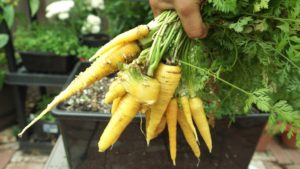Problem #1. Not preparing the soil well
 |
Garden soil lacking nutrients |
One of the most common problems that gardeners run into are nutritional deficiencies in their plants. Plants take nutrients from the soil and if your soil does not have the adequate nutrients for it to grow, they fail to thrive. All plants need three things to grow ? water, sunlight and nutrients. Nutrition is often overlooked and the deficiency of which results in unhealthy plants, discolored leaves, less yield and smaller fruits.
Solution:
Problem #2.Letting container plants go root bound
 |
Root bound container plant |
This is one of the worst things we tend to overlook in our garden especially if we have lots of containers. What this means is that the plant has the vigor to grow and has all the nutrients it needs but it doesn?t have any space, it is severely limited and constrained by the size of the container it?s growing in.
Solution
Problem #3.Insufficient calcium for tomatoes and pepper plants.
 |
Blossom End Rot |
Tomatoes and peppers are likely to suffer from one common problem which any gardener would not want to witness, blossom end rot where the bottom part of the plant or the fruits rot due to lack of calcium in the soil.
Solution
Problem #4.High nitrogen, crowding and insect damage
 |
High Nitrogen and Insect Damage in Radish |
This common problems plagues all root plants like radish and carrots where we add a lot of nitrogen in the soil in the form of manure. Too much nitrogen in the garden soil can cause an excess of green leaves with little to no fruits or vegetable production.
Solution
Problem #5. Over-watering
 |
Over-watered onions rot |
It?s easy to worry that your plants are not getting enough water that you tend to overwater them zealously. But that affects root plants and tubers especially when they have started forming bulbs. Onions for example can rot if the plants are over-watered when they are producing bulbs.
Solution
Problem #6.Premature harvesting
 |
Premature Harvest of Garlic |
Knowing when to harvest can be a nightmare for some, especially the root plants like garlic and onions. A lot of us including me are guilty of harvesting veggies early only to realize they had some more time into the growing season. Harvesting veggies earlier than its maturity time can result in smaller bulbs or unformed fruit and vegetable production.
Solution
Problem #7. Cauliflower woes
 |
Cauliflower damage & buttoning |
Cauliflowers are great to grow in your garden but two problems that commonly affect cauliflowers might discourage you from trying to grow these in your garden. The first one is insect damage due to aphids, infestation can result in shriveled leaves, undeveloped cauliflower heads which are tiny in size.
The second problem with growing cauliflowers is the buttoning of heads i.e. very tiny head formations. It usually happens if the temperatures go high, cauliflower is a cool season crop and does not withstand higher temperatures. The other reason that causes buttoning is high nitrogen content in the soil.
Solution (for insect damage)
Solution (for buttoning)
Problem #8.Growing plants in shade or not enough sunlight
 |
Watermelon plant not getting sunlight |
Most plants need about 6-8 hours of sunlight every day to thrive. Plant actively photosynthesize sunlight and water into energy which helps them grow leaves, stem and roots.
Solution
Problem #9.Not planting in the correct season
 |
Radish grown in summer heat |
Sometime we get anxious for gardening season and plant something out too early only to realize that the plant is not productive. And then you wait to start the entire process of germination all over. Not planting in the correct season will result in decreased to no yield at all because a vegetable needs either warm or cool weather to grow.
Solution
Problem #10.Not buying seeds from a trusted source
 |
Purple Radish turned out to be Yellow |
You may be tempted to buy cheap seeds from third party/foreign ebay sellers and end up growing something which wasn?t as advertised. Know the difference between heirloom, hybrid, organic and non GMO when buying seeds and never compromise on quality.
Solution
Always buy seeds from a trusted source. Here are some links where you can shop for your seeds
1. Amazon
2. Seed Savers
3. Baker’s Creek Seeds
To watch all these tips do watch our video from this blog post
A gardener learns more in the mistakes than in the successes ? Barbara Dodge Borland.

I believe sometimes buying from Amazon also is not a good idea, not 100%, 50-50 success and fail. i had some failures from AMAZON like 90% especially in terms of buying seeds/plants.
Otherwise its always Good and Recommended more than 100% in my opinion.
Thank you, your gardening videos are the best!